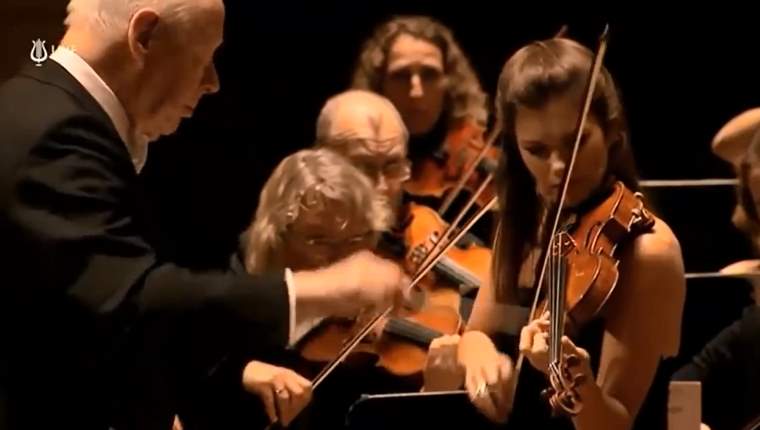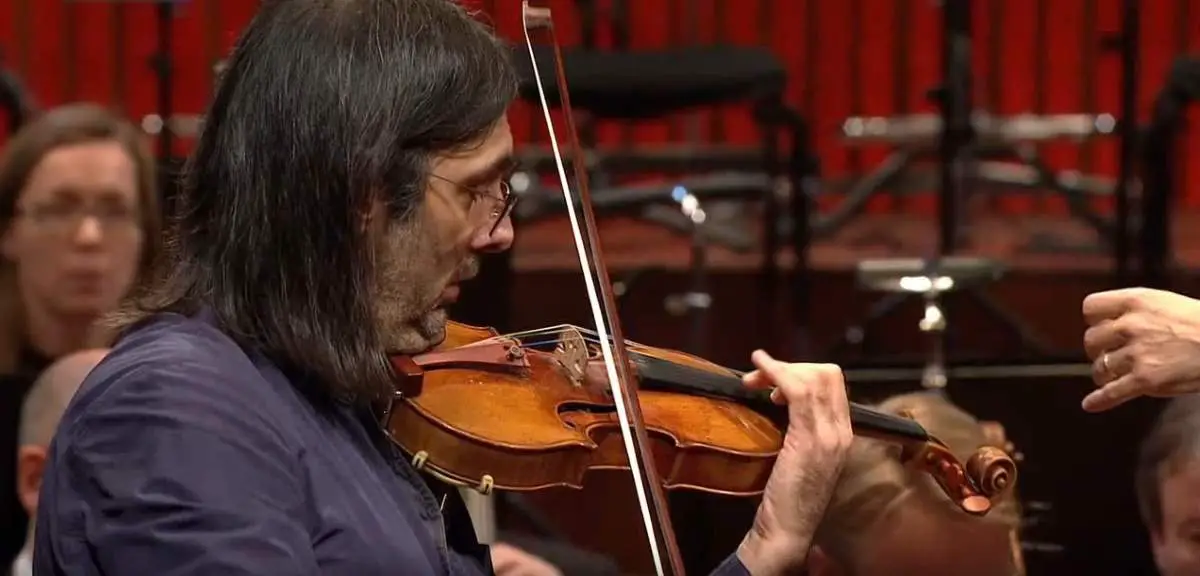Accompanied by the MÁV Symphony Orchestra (Budapest), Maxim Vengerov performs Johannes Brahms’ Violin Concerto in D major, Op. 77. Conductor: Gábor Takács-Nagy. Recorded at Kodály Centre in Pécs, Hungary on October 21, 2021. All cadenzas are written by Vengerov himself.
Johannes Brahms’ Violin Concerto
Johannes Brahms’ violin concerto has long been a favorite of virtuoso violinists.
Brahms began to write this work in the summer of 1878 while vacationing in the Austrian village of Pörtschach. He dedicated the work to Joseph Joachim (1831-1907), the Hungarian violinist, conductor, composer, and teacher, a longtime friend of the composer. The concerto showcased the virtuosic talents of Joachim.
It was premiered in Leipzig on January 1, 1879, by Joachim. Brahms conducted the premiere. It is Brahms’s only violin concerto, and, according to Joachim, one of the four great German violin concerti.
Brahms’ Violin Concerto is considered a masterpiece of the Romantic era and is notable for its combination of virtuosity and deep emotional expressiveness. The work has been a staple of the violin repertoire ever since its premiere and is frequently performed and recorded by some of the world’s greatest violinists.
Joseph Joachim told the guests at his 75th birthday party:
“The Germans have four violin concertos. The greatest, most uncompromising is Beethoven’s. The one by Brahms vies with it in seriousness. The richest, the most seductive, was written by Max Bruch. But the most inward, the heart’s jewel, is Felix Mendelssohn’s.”
The concerto is scored for solo violin and an orchestra consisting of flutes, oboes, clarinets, and bassoons; 4 horns in D, F, and E, 2 trumpets in D, timpani, and strings.
Movements
The piece follows the standard concerto form, with three movements in the pattern quick-slow-quick:
- Allegro non troppo (D major)
- Adagio (F major)
- Allegro giocoso, ma non troppo vivace – Poco più presto (D major)
1. Allegro non-troppo (D major)
The first movement of Brahms’ Violin Concerto in D major is a majestic and grandiose Allegro non-troppo. It begins with a lengthy orchestral introduction, featuring a series of richly layered and lushly orchestrated themes that set the stage for the entrance of the solo violin.
When the soloist enters, it does so with a powerful statement that leads into a cadenza-like passage, showcasing the virtuosic technique of the violinist. This passage leads to the exposition of the main theme, a soaring and expressive melody that is developed and elaborated upon throughout the movement.
The movement is characterized by its sense of dramatic tension, which is created through the interplay between the soloist and the orchestra. The orchestra supports and accompanies the soloist, but also engages in a dialogue with it, challenging and pushing the soloist to new heights of virtuosity and expressiveness.
The first movement of the Brahms Violin Concerto is a masterful display of Brahms’ skill as a composer and his understanding of the violin as a solo instrument. It is a rich and complex work that rewards repeated listening, revealing new depths of emotion and meaning with each hearing.
2. Adagio (F major)
The second movement of Brahms’ Violin Concerto in D major is a lyrical and introspective Adagio. It begins with a gentle, melancholic theme introduced by the solo violin, which is then taken up by the orchestra.
The movement is characterized by its warm and intimate tone, with the violin and orchestra engaging in a tender and emotional conversation. The soloist displays great sensitivity and expressiveness, producing a rich singing tone that perfectly captures the mood of the music.
The middle section of the movement features a more animated theme, but the mood soon returns to the introspective and melancholic character of the opening. The soloist is given ample opportunity to showcase their technical skill and musical sensitivity, with passages of delicate phrasing and expressive vibrato.
The second movement of the Brahms Violin Concerto is often considered the emotional heart of the work, with its intimate and expressive character providing a counterpoint to the dramatic tension of the first movement and the high energy of the third.
3. Allegro giocoso, ma non troppo vivace – Poco più presto (D major)
The finale of Brahms’ Violin Concerto in D major is a lively and energetic Allegro giocoso. It begins with a playful and dance-like theme introduced by the solo violin, which is then taken up by the orchestra.
The movement is characterized by its high energy and technical demands, with both the soloist and the orchestra engaging in virtuosic passages and intricate musical interplay. The soloist displays their technical mastery, with dazzling runs and rapid-fire arpeggios that showcase the full range of the violin’s capabilities.
The middle section of the movement features a more contemplative theme, which provides a brief moment of respite before the movement returns to its lively and exuberant character. The soloist and orchestra engage in a playful and spirited dialogue, with each pushing the other to new heights of technical virtuosity and musical expression.
Sources
- Violin Concerto (Brahms) on Wikipedia


![Brahms: Violin Concerto [Hilary Hahn]](https://cdn-0.andantemoderato.com/wp-content/uploads/2015/06/Brahms-Violin-Concerto-Hilary-Hahn-1024x576.jpg)